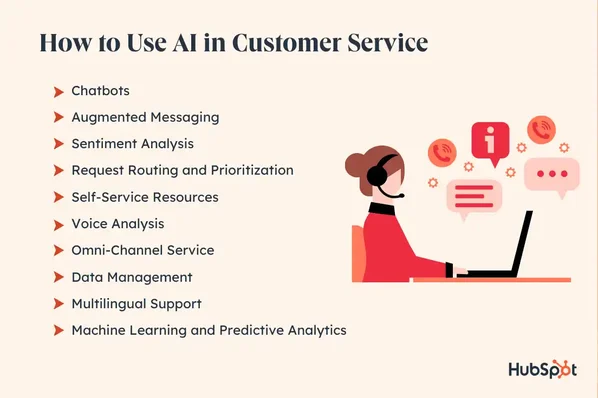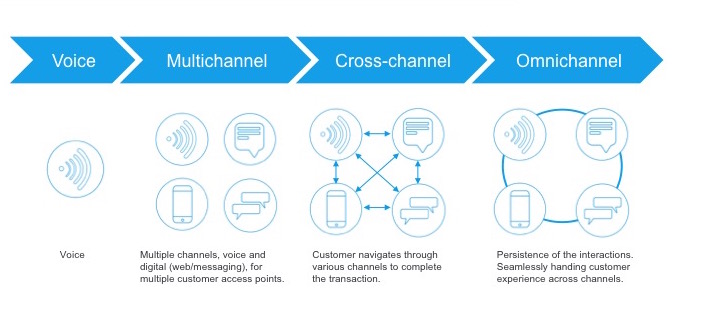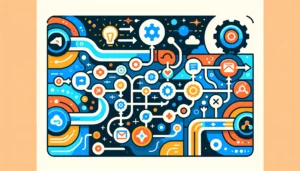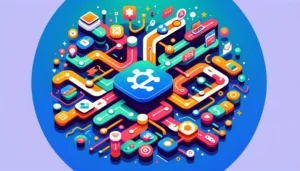Introduction
In the landscape of modern customer service, the concept of ‘omnichannel’ has taken center stage. But what exactly does omnichannel mean? At its core, omnichannel customer service is a strategy that integrates and unifies all customer communication channels – including phone, email, chat, social media, and even in-person interactions. This approach ensures a seamless, consistent customer experience, regardless of how or where a customer chooses to interact with a business.
In today’s digital age, where customers expect quick, efficient, and personalized service, an omnichannel approach is not just an advantage, but a necessity. With the advent of AI, this necessity transforms into an opportunity. AI enables businesses to automate and optimize customer interactions across all channels, providing a level of service that is not just efficient, but also deeply personalized and responsive. This blog post explores the transformative role of AI in automating omnichannel customer service, ensuring that businesses can meet and exceed the evolving expectations of their customers.
Understanding Omnichannel Customer Service
Omnichannel customer service transcends the traditional, siloed approach to customer interactions. It represents a shift towards a unified, customer-centric model where every channel is interconnected, offering a cohesive experience.
Consistency Across Channels: In an omnichannel approach, a customer’s journey is continuous and consistent. Whether they start a conversation through social media and then move to email or phone, the context and history of their interaction are preserved and accessible across all touchpoints.
Customer Centricity: This strategy places the customer at the center of the business universe. Every channel is optimized to serve customers where they are, how they prefer, and in a way that feels personal and intuitive to them.
Real-time Data Integration: Omnichannel customer service relies on real-time data integration. This means that customer interactions, regardless of the channel, are updated and available across the organization instantaneously. This integration allows for more informed and responsive customer service.
Enhanced Customer Experience: The ultimate goal of omnichannel service is to enhance the overall customer experience. By providing seamless, personalized, and efficient interactions, businesses can build stronger relationships with their customers, leading to increased loyalty and satisfaction.
Challenges in Implementation: Despite its advantages, implementing an effective omnichannel strategy can be challenging. It requires integrating various technology systems, training staff across different channels, and maintaining a consistent brand voice and policy across all platforms.

The Role of AI in Omnichannel Customer Service
The infusion of Artificial Intelligence (AI) into omnichannel customer service is revolutionizing how businesses interact with their customers. AI brings a level of intelligence and efficiency that tackles the inherent challenges of omnichannel service while enhancing customer experience. Here’s how AI is changing the game:
Seamless Integration Across Channels: AI algorithms can integrate customer data from various channels, providing a unified view of the customer journey. This integration ensures that the service is consistent and continuous, regardless of the channel.
Automated, 24/7 Customer Support: With AI-powered chatbots and virtual assistants, businesses can provide immediate responses to customer inquiries around the clock, significantly reducing wait times and improving customer satisfaction.
Personalized Customer Interactions: AI excels in personalizing customer interactions. By analyzing customer data and past behavior, AI can tailor recommendations, responses, and solutions, making each customer feel uniquely valued.
Predictive Customer Service: AI can predict customer needs and problems before they escalate, allowing businesses to proactively address issues. This foresight enhances customer satisfaction and loyalty.
Efficient Data Management and Analytics: AI systems can process and analyze vast amounts of data, providing insights that can drive strategic decisions and help refine customer service strategies.
By addressing the complexities and demands of omnichannel service, AI not only streamlines operations but also elevates the customer experience, making it more personal, efficient, and responsive.

Strategies for Implementing AI in Omnichannel Service
Implementing AI in an omnichannel customer service framework is a strategic endeavor that requires careful planning and execution. Here are key strategies to ensure effective implementation:
Identify Specific Goals and Objectives: Start by defining what you want to achieve with AI in your customer service – whether it’s improving response times, increasing personalization, or enhancing customer satisfaction. Clear objectives will guide the implementation process.
Choose the Right AI Technologies: Select AI tools and platforms that align with your customer service goals. Options include AI chatbots for instant customer responses, machine learning models for predictive analytics, and NLP tools for understanding customer sentiments.
Seamless Integration Across Platforms: Ensure that the AI solution integrates smoothly with existing customer service platforms. The goal is to create a unified experience for customers, whether they’re interacting via social media, email, phone, or chat.
Data-Driven Approach: Leverage customer data to train AI systems. The more data the AI has, the better it can learn and adapt to customer needs. Ensure compliance with data privacy regulations when using customer data.
Continuous Monitoring and Optimization: Regularly monitor the performance of AI tools and make necessary adjustments. AI systems learn over time, so continuous optimization is crucial for long-term success.
Staff Training and Support: Educate your customer service team about AI tools and their roles. Support from human agents is essential, especially in handling complex queries that AI cannot resolve.
Measuring Success and ROI: Implement metrics and KPIs to measure the effectiveness of AI in your omnichannel service. This could include metrics like customer satisfaction scores, resolution times, and overall cost savings.
By following these strategies, businesses can create an AI-powered omnichannel customer service system that is not only efficient and responsive but also deeply attuned to the evolving needs of their customers.
Real-World Examples and Case Studies
The integration of AI in omnichannel customer service is not just theoretical; many businesses have successfully implemented these solutions, reaping significant benefits. Here are some real-world examples and case studies that highlight the impact of AI in omnichannel customer service:
Case Study 1: Banking Sector
- A leading bank implemented an AI chatbot across its website and mobile app, resulting in a 40% reduction in customer service calls. The chatbot handles routine queries, allowing human agents to focus on more complex issues. Additionally, the AI system offers personalized financial advice to customers, leading to a 20% increase in customer satisfaction scores.
Case Study 2: Retail Industry
- A global retail chain integrated AI into its customer service across email, chat, and social media channels. The AI system provides product recommendations, stock availability updates, and order tracking. Since its implementation, the company has seen a 30% increase in online sales and a 25% reduction in return rates due to more accurate product recommendations.
Case Study 3: Healthcare Services
- A healthcare provider employed AI to streamline appointment scheduling and patient inquiries across phone, email, and a web portal. The AI system also sends personalized health tips and reminders for check-ups based on patient history. This omnichannel approach led to a 35% decrease in missed appointments and improved overall patient engagement.
These examples demonstrate how AI can transform customer service across various industries by enhancing efficiency, personalization, and customer satisfaction. They provide valuable insights for businesses considering AI integration into their omnichannel customer service strategies.
The Future of Customer Service: AI and Beyond
As we look towards the future, the role of AI in customer service is set to expand even further, promising more innovative solutions and deeper integration across channels. Here are some trends and predictions for the future of AI in omnichannel customer service:
Advanced Predictive Analytics: AI will increasingly use predictive analytics to anticipate customer needs and preferences, offering solutions and products even before the customer requests them. This proactive approach could redefine customer service, making it more intuitive and preemptive.
Enhanced Personalization: Future AI systems will offer even more sophisticated personalization, using deeper insights from data to create highly individualized customer experiences. This will further increase engagement and customer loyalty.
Integration with Emerging Technologies: AI is expected to integrate with other emerging technologies like augmented reality (AR) and virtual reality (VR), offering more immersive and interactive customer service experiences.
Voice and Visual AI Interactions: The use of voice recognition and visual AI is anticipated to grow, facilitating more natural and convenient modes of interaction for customers, akin to human-like communication.
Ethical AI and Transparency: As AI becomes more pervasive, there will be a greater focus on ethical AI practices and transparency. Businesses will need to ensure their AI systems are fair, unbiased, and respectful of customer privacy.
AI-empowered Human Agents: AI will not replace human agents but empower them with better tools and insights, enabling them to provide more effective and empathetic customer support.
The future of AI in omnichannel customer service is not only about technological advancements but also about creating deeper and more meaningful connections with customers. As AI continues to evolve, it will play a crucial role in shaping a customer service landscape that is more responsive, personal, and innovative.
Conclusion
The integration of AI into omnichannel customer service strategies signifies a significant shift towards more efficient, personalized, and proactive customer experiences. From AI-powered chatbots to sophisticated data analytics, AI is enabling businesses to meet customer expectations with unprecedented precision and care.
The case studies and future trends we’ve discussed underscore AI’s potential not just to enhance customer service operations but also to deepen customer relationships. In an era where customer experience is paramount, AI stands as a key differentiator for businesses seeking to stand out in a crowded market.
As AI continues to evolve and integrate with other cutting-edge technologies, its role in customer service will only grow more significant. Businesses that embrace this AI-driven transformation will be well-positioned to lead in customer satisfaction and innovation.
The future of customer service is here, and it’s powered by AI. Embracing AI is not just about staying ahead in the technological race; it’s about committing to providing the best possible service to your customers.






